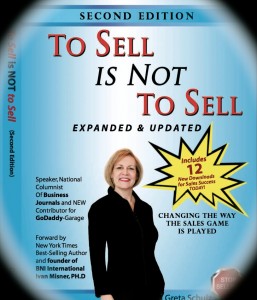What’s the new normal when it comes to developing business? This is not the old ‘ask a few questions, give your features and benefits and trial close’. The 70s wants their slick sales guy back. Today you need to be smart, curious and a true consultant to sell. Here are a few things that today are imperative in business growth.
1) Tell the prospect its OK to break up….Rejection is a result of trying to sell someone your product or service as opposed to tell them you what you are calling about, let them know it seems that because of what they do you could potentially work together, but (pull back) you don’t want to assume that you are a good fit. What you’d like to do is ask a few questions to see if the two of you are a fit and if not, we decide it’s a NO then we only wasted a few minutes? Sound OK?
This allows you to give a NO as an option right upfront. Then you have asked for it as opposed to a prospect pushing you away and that is the rejection.
2) Mining for customers is different today. Networking is the true key to finding and keeping customers but most people do it wrong. Networking events ate not for direct prospecting! Recognize this scenario?
“Hey do you guys use promotional products? here’s a sample, we can really help you!!”..” NO! Instead I say go to an event and look for Strategic Alliances, people that you can refer business back and forth to as opposed to hitting your potential prospects so hard. We all know building business on referrals is the best way to do business so lets network for good alliances that you can refer business to and that is a good source for your referrals.
3) Research should be used for credibility. Research is essential today before you pick up the phone and call anyone. No excuses! The most important reason to do your research on their web site, Google etc. is to create good, quality questions to ask them to engage your prospect in conversation and truly understand their needs not to tell them that you’ve researched their company and since they do this, we can sell you that…
4) If you need to discount to get the business is almost always a result of onof these things. a) The customer doesn’t truly trust you/your product or service so there is only price to use as a differentiator or b) you haven’t truly understood the need for the product. I know need seems simple but it isn’t.
What are they trying to say? What impression are they trying to leave, howdo they want to be seen? What are they using it for? There are lots of questions to not only understand what a prospect needs but the true deep-down ‘whys’. Asking questions will let you also gain credibility and trust but not Selling and truly asking and listening….
5) Listen and shut up!! Wow! If I could teach people that are in sales/business development to ask questions and listen there would be a lot more success in business!
Telling isn’t selling…but it comes from a good place. We are excited about what we represent and want other to be excited too but excitement doesn’t sell, questions and true engagement does.
Long ago we were taught to ask a few questions and when you hear a “ buying signal” jump in and tell them you can help with that and how. NO!
When you ask a question, wait for the answer and whatever the answer is, especially if it may be something your product or service can help with, the best next question is, “tell me about that”, then SHUT-UP!!!
Greta Schulz is President of SchulzBusiness, a sales Consulting and Training firm. She is a best selling author of “To Sell IS Not To Sell”. One of the Best Sales Speakers, She has a Second Edition “To Sell is Not To Sell” Out NOW
! For more information or free sales tips go to www.schulzbusiness.com and sign up for ‘GretaNomics’, a weekly video tip series or email sales questions to greta@schulzbusiness.com
Click Book to order










